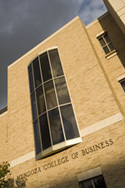
Using LEED-certified (Leadership in Energy and Environmental Design) buildings increases revenue generated by bank branches even when they offer the same products and services, according to a new study co-authored by University of Notre Dame management professors Edward Conlon and Ante Glavas.
In their study of 562 PNC branches (93 LEED, 469 non-LEED), “The Relationship between Corporate Sustainability and Firm Financial Performance,” Conlon and Glavas found that PNC employees who work in LEED-certified branches are more productive and engaged in their work.
Although they’re not yet certain if it’s because LEED buildings are more attractive to visit or because their employees are more satisfied, and consequently providing better service, Conlon and Glavas find that sustainability equals a big difference to the bottom line at LEED bank branches— $461,300 per employee after controlling for other variables that influence performance (e.g., consumer net worth, employee demographics, market demographics, size and age of branch, marketing spend).

The findings support a growing body of research that shows social responsibility and sustainability don’t have to be sacrificed for the sake of profitability. In fact, companies increasingly are finding just the opposite: They can achieve revenue or job growth while maintaining a high environmental and social impact.
“It’s a significant finding, and it surprised me,” says Conlon, associate dean and Sorin Society Professor of Management. “We compared the amount of money deposited at LEED and non-LEED branches, and we found more money has been deposited in the LEED branches. We divided the amount by the branches’ total number of employees to come up with a per-employee dollar amount.”

Most other studies on the business impact of sustainability have been conducted by companies whose products have ties to environmental concerns or that have become more sustainable as a reaction to stakeholder pressure and regulation, the researchers point out. Banks have no such ties, so whether considering a checking account, savings account or loan, the bank’s sustainable strategy – or lack thereof – doesn’t directly affect the product. Furthermore, PNC’s sustainability strategy was not reactionary, but rather a voluntary and visionary move to enhance its reputation, physical banking and working environment, as well as build pride among employees.
Also, says Conlon, the study uses firm accounting data to determine financial effects, while most others examine changes in market valuation. He says PNC was the ideal subject for their research for several reasons.
“PNC has built more than 100 LEED-certified buildings, which is more than any other U.S. company,” Conlon says. “So, PNC is perfect for a LEED study because they have a lot of them and the branches all do the same thing — same products, same systems — the only thing that’s different is the LEED strategy.”
The researchers say the strategy is working, whether it’s because the buildings look better or the people inside are more fulfilled.
“We think it’s a mix of the two,” Glavas says. “People are certainly proud to be working in LEED buildings.”
“Suffice it to say, I think PNC is getting a payback on its LEED investment,” Conlon says.
Contacts: Edward Conlon, 574-631-9295, conlon.6@nd.edu; Ante Glavas, 574-631-9469, aglavas@nd.edu
Originally published by at newsinfo.nd.edu on March 26, 2012.